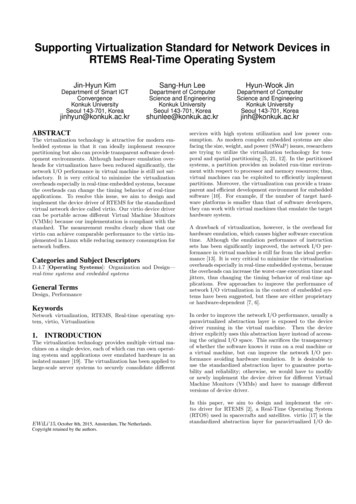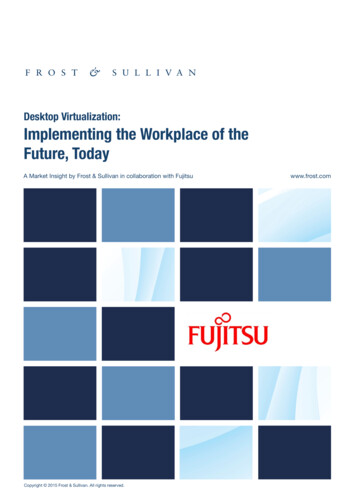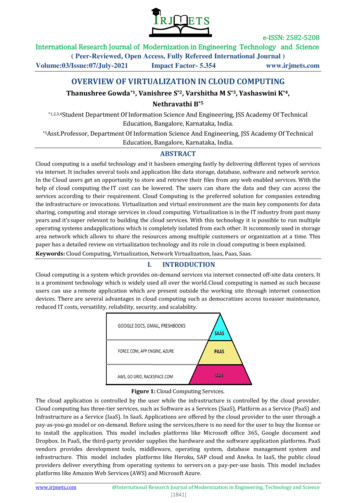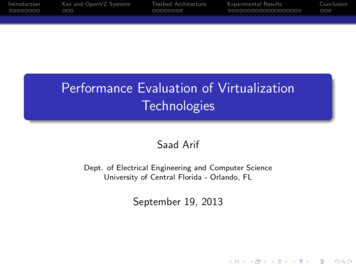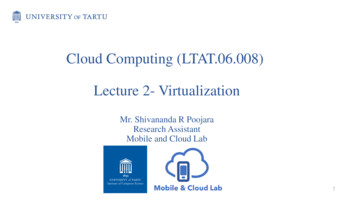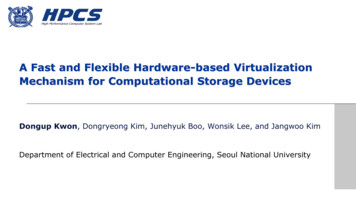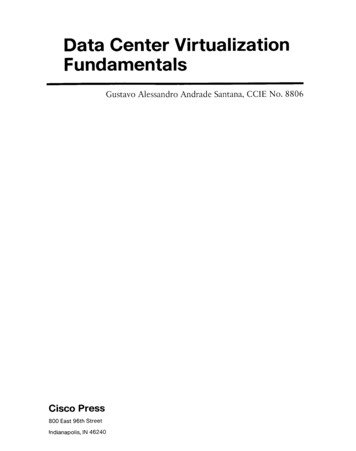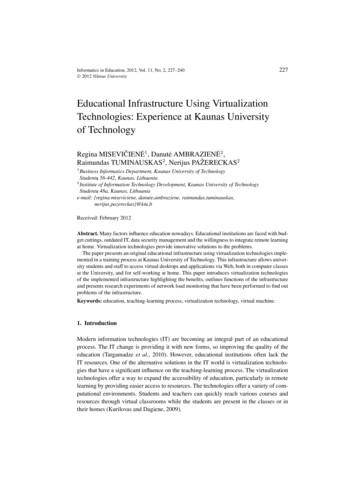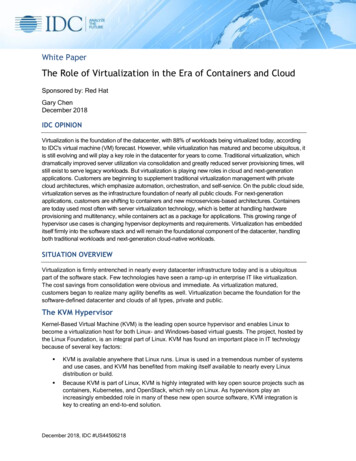
Transcription
White PaperThe Role of Virtualization in the Era of Containers and CloudSponsored by: Red HatGary ChenDecember 2018IDC OPINIONVirtualization is the foundation of the datacenter, with 88% of workloads being virtualized today, accordingto IDC's virtual machine (VM) forecast. However, while virtualization has matured and become ubiquitous, itis still evolving and will play a key role in the datacenter for years to come. Traditional virtualization, whichdramatically improved server utilization via consolidation and greatly reduced server provisioning times, willstill exist to serve legacy workloads. But virtualization is playing new roles in cloud and next-generationapplications. Customers are beginning to supplement traditional virtualization management with privatecloud architectures, which emphasize automation, orchestration, and self-service. On the public cloud side,virtualization serves as the infrastructure foundation of nearly all public clouds. For next-generationapplications, customers are shifting to containers and new microservices-based architectures. Containersare today used most often with server virtualization technology, which is better at handling hardwareprovisioning and multitenancy, while containers act as a package for applications. This growing range ofhypervisor use cases is changing hypervisor deployments and requirements. Virtualization has embeddeditself firmly into the software stack and will remain the foundational component of the datacenter, handlingboth traditional workloads and next-generation cloud-native workloads.SITUATION OVERVIEWVirtualization is firmly entrenched in nearly every datacenter infrastructure today and is a ubiquitouspart of the software stack. Few technologies have seen a ramp-up in enterprise IT like virtualization.The cost savings from consolidation were obvious and immediate. As virtualization matured,customers began to realize many agility benefits as well. Virtualization became the foundation for thesoftware-defined datacenter and clouds of all types, private and public.The KVM HypervisorKernel-Based Virtual Machine (KVM) is the leading open source hypervisor and enables Linux tobecome a virtualization host for both Linux- and Windows-based virtual guests. The project, hosted bythe Linux Foundation, is an integral part of Linux. KVM has found an important place in IT technologybecause of several key factors: KVM is available anywhere that Linux runs. Linux is used in a tremendous number of systemsand use cases, and KVM has benefited from making itself available to nearly every Linuxdistribution or build. Because KVM is part of Linux, KVM is highly integrated with key open source projects such ascontainers, Kubernetes, and OpenStack, which rely on Linux. As hypervisors play anincreasingly embedded role in many of these new open source software, KVM integration iskey to creating an end-to-end solution.December 2018, IDC #US44506218
Much of the innovation around cloud and containers is done in open source. Linux, and bydefault KVM, is often a part of, or integrated with, these solutions as foundational elementsbecause Linux and KVM are the standard for open source infrastructure. KVM has been used and proven in a wide variety of use cases over time, includingon-premises enterprise virtualization, private cloud (such as OpenStack), hyperconverged andother hardware systems, public cloud, and telco networks for network functions virtualization(NFV). The ongoing evolution of KVM demonstrates its maturity, flexibility, and near-universalcompatibility with anything that can run Linux.Shifting Infrastructure RequirementsThe IT industry is constantly evolving and today there is a shift happening in how apps are architectedand built. Digital transformation is pushing businesses to invest more in software and deliver thissoftware increasingly faster. Modern applications are beginning to use a cloud-native microservicesbased architecture. The use of microservices decomposes an application into smaller logical servicesthat can be developed in parallel and updated and scaled independently. Developers are alsoincreasingly moving to Agile development methodologies, allowing them to ship code continuously,and becoming more integrated with operations teams (DevOps).As the application architectures and development methodologies change, it is driving the requirement fordifferent infrastructures optimized to support them. The pace of software development and deployment isincreasing dramatically, and infrastructure shouldn't hold back that pace. This is one of the reasons whythe industry has been seeing a shift to cloudlike infrastructures, both private and public. Theseinfrastructures are API driven, highly scalable, available on demand, and fully automated. Most of theseclouds have historically been VM based but now are evolving to also support containers.What Is a Container?Containers use various operating system (OS) abstraction and virtualization technologies to provide anisolated, resource-controlled environment to run applications. It is basically a type of sandbox around anormal application OS process and is generally considered to be much more isolated than anuncontainerized process, but not as isolated as a VM. Container images define how applications arepackaged and only contain the application and its dependencies such as libraries, configurations,runtimes, and tools, making it more lightweight than a VM. The container image and runtime arestandardized through the Open Container Initiative (OCI), making containers highly portable anduniversal. Kubernetes, a container management system, is a de facto standard in the industry today,which makes the container control plane standardized as well.Containers are extensions of operating systems, a better way of sandboxing an application process,making the OS the foundation for container execution. Containers have a long history with Linux.Some of the key functions needed for containers began to be developed in the Linux kernel a decadeago. When Docker began developing the modern container, now part of OCI, it was developed onLinux. While today containers support other operating systems such as Windows, IDC research showsthat nearly 80% of containers are on Linux. 2018 IDC#US445062182
Why Are Enterprises Adopting Containers?Containers are deployed to meet a wide variety of application development and infrastructure needs.Figure 1 summarizes findings from a recent IDC survey that uncovered 14 of these drivers.We summarize a few key drivers in the sections that follow.FIGURE 1Top Container DriversQ.What were the primary drivers that caused your organization to initially deploy containers?Improve securityIncrease developer productivityNeed to modernize existing applications to make them more relevantInternet of Things/edge computingImprove reliability/availability/scalability of applications and infrastructureSupport cloud-native microservices application architectureBig data/machine learning/artificial intelligence (AI) initiativesIncrease application development speed to improve time to marketReduce infrastructure costs/improve infrastructure efficiencyReduce operational efficiency/management costsSupport for mobile initiativesNeeded to move applications off old or unsupported operating systemsPursuing a multicloud or hybrid cloud strategyPursue digital transformation and new business innovationOther (please specify)0%10%20%30%40%n 301Source: IDC's Container Infrastructure Software Survey, January 2018Containers Are Highly Synergistic with Microservices and Agile DevelopmentContainers are an efficient way to encapsulate a microservice into highly portable units for deploymentto a variety of infrastructures and clouds.With Agile development, the workflow and software pipelines are becoming accelerated, often with theuse of continuous integration/continuous deployment (CI/CD) systems. Containers are lightweight andportable, making them a good vessel to put code into in order to push them through these newsoftware pipelines and reduce the time to deployment.Containers Enable Application ModernizationContainers can also be used for some existing applications, though some may require some level ofcode changes or refactoring. This allows the application to be more portable for migration to the publiccloud and can also retrofit the application into newer developer workflows and software pipelines. 2018 IDC#US445062183
Containers Enable Automated Operations at Web ScaleContainer orchestration and management systems are designed to deploy and manage distributed,cloud-native applications. To do this at any scale, full automation is a core mantra of these systems.These systems are also designed to operate at web scale, providing scalability and resiliencycapabilities to modern applications. However, scalability and resiliency are still highly dependent onthe application's architecture, with cloud-native applications designed to better handle these aspects.FUTURE OUTLOOKThe Role of KVM in the Era of Containers and CloudVirtualization and KVM are core technologies that currently underpin multiple types of openinfrastructure and will continue to power new infrastructure for the future. KVM is seen in severaldifferent deployment scenarios: As part of a traditional virtualization solution. Customers deploy fleets of hypervisors onservers, managed through a centralized console. As part of a private or public cloud. OpenStack is primarily used in private clouds, and KVM isthe default hypervisor for OpenStack. Public cloud providers largely prefer open sourcehypervisors for reasons of cost and customizability, and KVM is the preferred choice today. As part of a container platform. Containers are an OS-level virtualization technology and stillrequire infrastructure to run on, like any other OS or application. And like other workloads,virtualized infrastructure is generally preferred for containers today because it is much easierto manage than bare metal and is widely available in today's datacenters. However, theperformance benefit of running containers on bare metal is leading to increasing interest in thisdeployment model for the future.Containers Versus Virtualization?One common misconception today is that containers replace virtualization. While some of thefunctions of containers resemble virtualization, they actually operate very differently, and containersgenerally complement virtualization. Virtualization operates at the hardware level, virtualizing serverhardware and carving it up into smaller pieces. Containers operate at the operating system level andapplication packaging level. IDC data shows that 72% of enterprise containers run virtualized todayversus bare metal. Hypervisors provide key functionality to containers: Hypervisors provide much stronger isolation than containers. This is key especially in thepublic cloud where you would never see different tenants separated only by a containerboundary. Inside enterprises also, there are many reasons to use a hypervisor for isolation.Different business units or workloads may have different policies or regulatory requirements,and a hypervisor provides additional separation in these cases. Containers don't absolve organizations from having to provide a stable and robustinfrastructure underneath. Hypervisors are standard today for hardware provisioning andhave very mature orchestration tools for this task, and they are already in place in nearlyall enterprises. More flexible OS choices are available. If a container host OS was installed on bare metal, allcontainers would share that same kernel. Using VMs to run multiple container host OSs allowsmore flexible mixing and matching of OSs. This could be a mix of Windows and Linux, differentversions of the same OS, and different patch levels that might be needed by different users 2018 IDC#US445062184
and applications. The reality today is that enterprise customers run many different patch levelsand versions of an OS and use both Windows and Linux containers. Managing dedicatedphysical nodes for each type would create a lot of management overhead.While IDC believes that most containers will continue to run on hypervisors, that does not mean thatthe dynamics of the hypervisor market will not be affected. Hypervisors as an embedded part of acontainer stack play a much different role today than traditional VMs. Many of the requirements andvalue of the hypervisor in a container stack will be different, and this could alter the feature set andcost of hypervisors going forward.Container and VM CoexistenceMost enterprises will run a mixed mode of VMs and containers for the foreseeable future. Not everyapplication can be easily containerized, as container technology is not fully transparent and backwardcompatible like virtualization was. Figure 2 illustrates recent customer data from an IDC study showingwhat levels of modification were required of existing applications to containerize them.The reality is that many existing applications will never be containerized. The opportunity tocontainerize some applications may not come until that application is decommissioned and a wholenew replacement is brought in. For a lot of applications, this is a very very long time.Enterprises have always accumulated and managed multiple generations of technology in parallel.It would certainly be nice to always be using the latest and greatest, but this isn't financially viable.Enterprise applications will be deployed into both VMs and containers for the foreseeable future, andenterprises will need a converged platform to support both. Why a converged platform? Having VMsand containers in separate silos creates integration and management problems. For example,applications commonly talk to or integrate with other applications. Some of these applications might beVM based, while others will be containerized. Even different parts of the same applications might berunning in different technologies, with say the database tier in a VM and the web tier in containers.To effectively manage these applications and optimize and monitor them, customers need to manageand integrate across multiple generations of technology. KVM has the opportunity to underpin all ofthese deployment types, whether it is managed with traditional virtualization management, privatecloud, or a container system like Kubernetes. 2018 IDC#US445062185
FIGURE 2Modifications Required for Containerization of Existing AppsQ.For your existing applications that were migrated to a container, please indicate thepercentage breakdown of what level of modification was required to containerize theseapplications.Little to no modifications required to containerize applicationModerate amount of modifications required to containerize applicationSignificant modifications required to containerize application0%5%10%15%20%25%30%35%40%45%n 301Source: IDC's Container Infrastructure Software Survey, January 2018VMs in a Container?KVM opens up some interesting possibilities because it is just another process in the Linux OS.Because of this, a Linux instance can serve multiple roles simultaneously, serving as both a hypervisorand a container host (along with other general-purpose OS functions). A recent open source projectcalled KubeVirt leverages this to bring together the world of VMs and containers in a new way, byputting a VM into a container.How does this work? Well, remember that KVM is simply a kernel module that enables the Linux kernelto become a hypervisor and reuses many of the OS features already there for virtualization. Thus, withKVM, a VM is just another Linux process. Now remember that a container on Linux is just a normalprocess that has additional sandboxing applied to it. Using Linux and KubeVirt, we can take that KVMVM process and apply a container sandbox around it. But why would someone want to do that? By wrapping a VM in a container, the VM can be managed with any choice of modern toolingsuch as Kubernetes. This allows VMs to leverage the modern APIs, automation, andmanagement paradigms that are prevalent in container platforms. VMs can be put into modern workflows and software pipelines to modernize VM-basedapplications. It's possible to integrate traditional assets into modern container applications, creating hybridVM- and container-based apps. Converging VMs and containers onto the same platform simplifies management, operations,troubleshooting, and monitoring. 2018 IDC#US445062186
RED HAT PROFILERed Hat has been a central figure in fostering the development of KVM. With Red Hat's influence inLinux and open source and the company's long history of successfully commercializing many opensource projects, KVM powers many forms of modern Red Hat infrastructure: The Red Hat Virtualization offering consists of an enterprise implementation of the KVMhypervisor that is part of an optimized version of Red Hat Enterprise Linux (RHEL). It alsoincludes traditional virtualization management based on the open source oVirt project, which isa Red Hat JBoss Middleware Java application, allowing it to run on a fully open source stackof Linux and Java. Red Hat OpenStack Platform brings a modern private cloud environment to enterprises byvirtualizing resources from industry-standard hardware, organizes those resources into clouds,and manages those resources so users can access what they need, on demand. RHEL andKVM play an instrumental role in OpenStack, powering the underlying compute nodes. Red Hat OpenShift Container Platform, Red Hat's enterprise distribution of Kubernetes, canrun on either bare metal or virtualized servers. While there are pros and cons to both, themajority of container deployments are on virtualized servers like Red Hat Virtualization forseveral reasons: Easier management than bare metal with the virtualization management web UI andREST API Coexistence with existing VM-based workloads Infrastructure scalability for OpenShift nodes Modernizes the existing virtualization platform with containers and cloudlike servicesRed Hat Container-Native Virtualization (CNV) is a new technology currently in incubationstatus that helps development teams that have adopted or want to adopt Kubernetes as part ofthe Red Hat OpenShift Container Platform but have existing virtual machine–based workloadsthat cannot be easily containerized. This technology provides a unified platform wheredevelopers can build, modify, and deploy applications in containers and VMs within a sharedenvironment. CNV is based on the KubeVirt open source project and powered by the sameKVM technology in Red Hat Virtualization and Red Hat OpenStack Platform.By leveraging KVM, Red Hat is uniquely positioned to help businesses grow beyond traditionalvirtualization to containers, private cloud, and hybrid cloud management. All parts of the Red Hat stackare open source, but they are all integrated with the same KVM hypervisor, tested as one, andsupported by a single vendor.Red Hat Infrastructure Migration SolutionThe Red Hat infrastructure migration solution helps organizations reduce the cost of their existinginfrastructure investments. The solution analyzes the cost of the existing infrastructure and provides analternative virtualization platform for both new growth and existing workloads. New workloads can bedelivered on the alternative platform in an automated fashion with self-service, ensuring that IT canquickly recreate the workloads on future platforms, such as public clouds, without a heavy burden.Existing workloads are analyzed and migrated using a proven methodology to ensure all businessrequirements are satisfied for the workload, such as migrating within proper change control windowsand having approvals from needed stakeholders. 2018 IDC#US445062187
A typical migration journey has three phases: Discovery session. In this first phase, Red Hat Consulting engages with an organization in acomplimentary session to fully understand and document the requirements and scope of themigration journey. Migration pilot. In this phase, the alternative platform is deployed and operationalized, andseveral pilot migrations take place to ensure all requirements are met for a large-scalemigration. Migration at scale. In this final phase, the customer migrates workloads at scale following thedocumented plan that was created in the previous phases with support from Red HatCustomer Experience and Engagement.Red Hat Subscription ModelLike all Red Hat products, Red Hat Virtualization is available through a subscription model thatincludes software access, support, patches, and community participation. The standalone Red HatVirtualization subscription is a single edition that consists of the manager and hypervisor and includesall core enterprise virtualization features built in, including live migration, high availability, user portal,and reports. Red Hat Virtualization is also now a key part of larger Red Hat bundles and suite productsin areas including OpenStack private clouds, containers, and platform-as-a-service (PaaS) solutions.Red Hat OpenStack Platform and Red Hat OpenShift Container Platform are also available through anannual subscription model.Red Hat–Microsoft InteroperabilityEven though KVM is a Linux-based virtualization solution, Windows is treated as a first-class guest.Red Hat and Microsoft have entered into an interoperability and support agreement that ensures thatcustomers will be able to use a combination of solutions from the two companies with support fromboth vendors.Within the Red Hat Virtualization environment, Windows VMs are able to use the same full scalabilityfeatures as Linux VMs, such as the number of vCPUs and the amount of vRAM. In addition, Red Hatprovides Windows drivers for Red Hat Virtualization, which are conveniently available through theWindows Update service. Red Hat has attained Microsoft's Server Virtualization Validation Program(SVVP) certification, which means that Windows and all Microsoft software are validated for andsupported on Red Hat Virtualization.In addition, Red Hat certifies Red Hat Enterprise Linux and all Red Hat software on Hyper-V.Red Hat Enterprise Linux 6.4 and higher include the Microsoft Hyper-V Linux drivers, which are now inthe upstream Linux code. These drivers improve the overall performance of Red Hat Enterprise Linuxwhen running as a guest on Microsoft Hyper-V. Installation support for the Hyper-V paravirtualizationdrivers enables easy deployment of Red Hat Enterprise Linux as a guest in these environments.The Red Hat and Microsoft collaboration goes well beyond just virtualization support. The twocompanies have entered into a broad corporate-level partnership that includes engineeringcollaboration, certification, and joint support across a number of areas, including Azure, .NET, andmanagement. The most recent area is support for Windows containers within the OpenShift ContainerPlatform. Both Red Hat and Microsoft engineering teams have publicly committed to the project, with aDeveloper Preview Program launching soon. 2018 IDC#US445062188
CHALLENGES/OPPORTUNITIESChallenges Expanding beyond the Linux install base. KVM's close ties with Linux create some challengesbecause customers perceive KVM-based products as a solution for Linux only, althoughWindows is well supported. Customers not familiar with Linux may be hesitant to try Red HatKVM–based products, fearing that they do not have Linux skills and knowledge. Entrenched virtualization competitors. Even with technologies like CNV, migration of VMs islikely to be from VMware, and traditionally, migrations from VMware have been difficult to pulloff for a variety of reasons. While CNV has interesting benefits for running mixed-modeapplications, migrating off VMware to KVM and then into a container may be difficult forcustomers to accomplish at large scale. Building ecosystem and independent software vendor (ISV) support and certification. Theecosystem is critical in adding value to any system platform and is a force multiplier for marketsuccess. Red Hat Virtualization and Red Hat OpenStack are competing with other hypervisorsand cloud platforms for partner attention. However, OpenShift has carved out an early positionin the container market and has drawn good attention from partners.Opportunities Cloud, web, and telco providers. Open source has experienced great early success in thecloud as service providers have liked the customizable code and the low cost. While thisopens doors for commercial open source vendors, it has also been historically challenging toconvert these service providers to use paid subscription support services for solutions basedon open source software. Telcos doing NFV have gravitated toward KVM and OpenStack, abright spot for those technologies. The reach of Linux. As an integral part of Linux, the KVM hypervisor exists wherever Linuxexists. Linux users already expect KVM virtualization services to always be available to them.The wide and varied distribution model for Linux will spread KVM broadly, with Linux vendorstasked with getting users to embrace it and pay for it. New deployment models and stacks for cloud-native applications. Technologies such asOpenStack, containers, KVM, and open source are heavily preferred in cloud-nativeecosystems. While traditional virtualization is a very mature market, the needs and economicsof new emerging cloud stacks are very different, and these new applications have no existingdependencies. KVM has already established key positions in these markets, the de factohypervisor for anything Linux or open source based. Further, the potential to manageKVM-based virtual machines with the Kubernetes container orchestration platform viaContainer-Native Virtualization is appealing for these complex cloud-native environments. Open source cloud and containers. Open source is more accepted than ever and driving muchof the innovation today in the industry. Red Hat Virtualization, OpenStack, and OpenShift cancapitalize on the growing wave of open source affinity to grow adoption.CONCLUSIONWith the many changes happening to infrastructure in the cloud era, virtualization is still the foundationfor infrastructure — tomorrow's and yesterday's. Virtualization is finding new and different roles undernext-generation infrastructure, supporting private and public clouds and new compute models such ascontainers while still maintaining its massive base of traditional infrastructure. 2018 IDC#US445062189
Red Hat Virtualization is a mature open virtualization platform that builds off KVM, the open sourcestandard hypervisor. Red Hat's history of commercializing Linux and other open source softwarepositions the company to be a leader in bringing KVM to enterprises. Red Hat Virtualization is thecommon foundation across traditional and cloud stacks. Red Hat's KVM-based virtualizationtechnology can be managed through traditional oVirt virtualization management, OpenStack cloudinfrastructure, or the very modern OpenShift Container Platform. Red Hat Virtualization can power allthese platforms and is highly integrated through common management technologies, such as Red HatAnsible Tower and Red Hat CloudForms. Red Hat, a trusted vendor in enterprise open source, is wellpositioned to deliver open source innovation in a fully supported, tested, and integrated stack that canspan traditional and cloud scenarios. 2018 IDC#US4450621810
About IDCInternational Data Corporation (IDC) is the premier global provider of market intelligence, advisoryservices, and events for the information technology, telecommunications and consumer technologymarkets. IDC helps IT professionals, business executives, and the investment community make factbased decisions on technology purchases and business strategy. More than 1,100 IDC analystsprovide global, regional, and local expertise on technology and industry opportunities and trends inover 110 countries worldwide. For 50 years, IDC has provided strategic insights to help our clientsachieve their key business objectives. IDC is a subsidiary of IDG, the world's leading technologymedia, research, and events company.Global Headquarters5 Speen StreetFramingham, MA 01701USA508.872.8200Twitter: @IDCidc-community.comwww.idc.comCopyright NoticeExternal Publication of IDC Information and Data — Any IDC information that is to be used in advertising, pressreleases, or promotional materials requires prior written approval from the appropriate IDC Vice President orCountry Manager. A draft of the proposed document should accompany any such request. IDC reserves the rightto deny approval of external usage for any reason.Copyright 2018 IDC. Reproduction without written permission is completely forbidden.
virtualization serves as the infrastructure foundation of nearly all public clouds. For next-generation applications, customers are shifting to containers and new microservices-based architectures. Containers are today used most often with server virtualization technology, which is better at handling hardware


